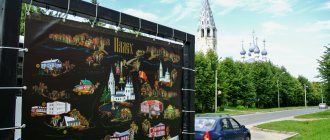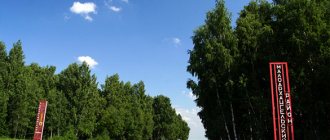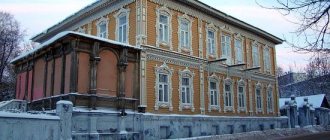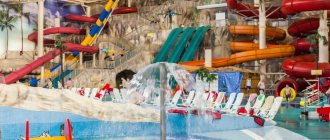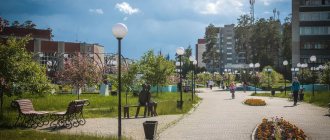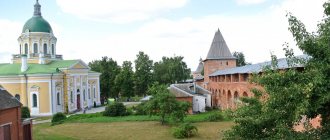Black boxes with fairy-tale scenes are widely known outside of Russia - products from the village of Palekh, located in the Ivanovo region. It is Palekh boxes (caskets, brooches), along with Zhostovo trays and Khokhloma, that go abroad as souvenirs in the luggage of foreign tourists. However, in the village of Palekh there is something to see besides the production of boxes: there are 19 objects that you can visit, including: the Museum of Icons, the House-Museum of I.I. Golikov, Museum of Palekh Art, Holy Cross Church, completely painted by Palekh masters.
Palekh
Palekh is one of the centers of Russian folk crafts, located 350 km from Moscow and 60 km from Ivanovo. The population of Palekh is only 4,800 people (as of 2022). A visit to Palekh can be combined with sightseeing in the Ivanovo region, the city of Ivanovo, Ples, Kineshma.
Palekh is the “main competitor” of Fedoskino near Moscow, since they also paint papier-mâché boxes here. During my next vacation, I managed to visit the village of Palekh on an excursion, which I will tell readers of the site about.
At the beginning of the excursion, we were disembarked from the bus next to a poster showing that in Palekh there are at least 19 objects worthy of tourist attention: But in our program, unfortunately, there was only time for a cursory examination of four of them.
Museum of Icons in Palekh
Our acquaintance with Palekh began with the Museum of Icons. It was a real discovery for me that before the revolution Palekh was one of the centers of icon painting and had nothing to do with the manufacture of boxes. Local icon painters have developed their own original and recognizable style with their own professional secrets.
The museum collection is rich and includes not only Palekh icons, but also those brought over many years from other ancient cities of Russia. There are even wooden sculptures from Old Believer churches.
Palekh Icon Museum
Palekh Icon Museum
Unfortunately, I configured the settings incorrectly and most of the pictures turned out poorly. After all, as it turned out, the most important thing in a Palekh icon is the color scheme.
Palekh Icon Museum
Palekh Icon Museum
Piazza dei Signori - the historical center of the city
The historical center of Padua is formed by several squares, one of the main ones is Piazza della Senoria. For several centuries, the most important city events took place here, and the arched galleries and palazzos typical of Venice remind us that Padua was part of the Venetian Republic. In the evenings, restaurants set up tables on the streets, and the atmosphere turns from historical to romantic.
Piazza dei Signori. Catarina Belova
Here is also one of the main architectural monuments of Padua - the Admiralty building, decorated with an ancient clock. They show not only the time, but also the day of the week, the current month, date, and phases of the moon.
Antique clock. Merlin74
House-Museum of I.I. Golikov in Palekh
Next we proceeded to the house-museum of I.I. Golikova. This is the person who, in the socio-economic conditions that changed after 1917, was able to “reorient” artists to a new type of activity. The changing internal political system threatened to destroy Palekh art. I.I. Golikov and a group of like-minded people founded a decorative and artistic artel. Of course, I had to part with icon painting, but the famous style was able to “take root” on decorative items. In particular, in the house-museum there is a copy of the book “The Tale of Igor’s Campaign,” which was illustrated by I.I. Golikov.
house-museum of I.I.Golikov
The house, which became a museum, was built by the artist himself in 1928 for his family. The conditions of his life and work are recreated here; things that belonged to him are displayed. Also here are documents and photographs illustrating the process of creating a new direction of Palekh art, and a stand has been set up that clearly shows the process of creating a Palekh box.
house-museum of I.I.Golikov
I only took one photo inside the house. Surprisingly, even if you come with a group, you have to pay 150 rubles for photography. They didn’t tell us about this at the Icon Museum. But at the Museum of Palekh Art, which we went to after I.I. Golikov’s house, they even reprimanded me when they saw that I was taking a lot of pictures. True, I didn’t pay anything, but I stopped taking photographs.
house-museum of I.I.Golikov
Route to explore Liege on your own for 1 day
For the first visit to Liege, experienced travelers recommend starting to explore the city with religious buildings and the most frequently visited architectural monuments.
These include:
- Church of St. Bartholomew. It attracts tourists with its unusual architecture: red columns stand out in bright stripes against a white sandstone background. Located at Place St Barthélémy 8.
- Church of St. John. An architecturally interesting structure (octagonal in shape). Address: Place Xavier Neujean 32.
- Palace of Prince-Bishops. Castle museum built 10 centuries ago. Address: Place Saint-Lambert 18.
- Curtius Museum. An ancient mansion replete with collections of antiques, classical and modern art. You can find it at Quai de Maestricht 13.
- Liege Cathedral. Catholic church named after Paul the Evangelist. The church is famous for housing the relics of St. Lambert. You can join the shrines at Place de la Cathédrale 6.
- Royal Opera. The largest opera among other European representatives. Located at Place de l'Opéra.
Museum of Palekh Art
The Museum of Palekh Art exhibits those objects that were made by Soviet masters, as well as modern works. And it's not just the boxes. There is furniture, wall hangings, stationery and jewelry. There is a showcase with porcelain products. At one time they tried to use Palekh painting to decorate plates and other porcelain objects, but it did not work.
Museum of Palekh Art
Museum of Palekh Art
The themes for painting the products were epics, Russian folk tales and Pushkin's tales, as well as the life of Soviet people, although I would call the subjects more propaganda than everyday. I couldn’t photograph one wonderful work called “The Pioneers’ Trial of Baba Yaga.”
I liked the box dedicated to the victory in the Great Patriotic War.
palekh
Museum of Palekh Art
Unfortunately, most of the exhibits are not in very good condition: the varnish covering the miniatures is badly cracked. The fact is that Palekh did not have its own varnish. He wasn't needed here. They turned to Fedoskino for a prescription, but they refused to provide it. Several years passed before Palekh created its own signature varnish for products.
Museum of Palekh Art
Museum of Palekh Art
How to get there?
regularly conducts trips to the cities of the Golden Ring of Russia.
Travel from Kazan
Travel from Cheboksary
Travel from Yoshkar-Ola
Considering creative products created by talented craftsmen, many ask the question of where Palekh is located. Most guests prefer to travel by private car. It's comfortable. The distance Moscow-Palekh is 400 kilometers. Traffic will be carried out along the M7 highway. You need to go through Vladimir and Suzdal. The total duration of the journey is 6-6.5 hours.
There is a daily bus to Palekh. Boarding is carried out from the Shchelkovsky railway station in Moscow. The stop is made at Yuzha station. There are also buses going from Moscow to Ivanovo. At the final station you will need to change to the Ivanovo-Palekh bus.
There is a railway connection. Shuya station is located 75 kilometers from the settlement. This solution is chosen by those traveling from St. Petersburg or Nizhny Novgorod. If you are heading from the capital, then a train with a direction such as Moscow-Kineshma will do, then you will need to transfer to a bus or use a taxi. Buses run frequently and the journey takes 1.5 hours.
If you want to avoid additional hassle, then book an excursion to Palekh from Moscow and other cities. The trip will be carried out on a comfortable bus accompanied by a guide.
How to distinguish real products from Palekh from fakes at the household level
- Fake Palekh boxes have filled all souvenir shops and markets, so how can you distinguish real products from Palekh from fakes? The museum told us some secrets:
- Most often, products from Palekh are black on the outside (green and blue are very rare), but always red on the inside;
- High quality polishing of both external and internal surfaces. There should be no scratches, stains or blisters;
- The lids of the boxes (caskets and caskets) are tightly fitted to the base - the box;
- Special marks: in the lower left corner look for the signature “palekh” in gold, in the lower right – the author’s surname;
- On the bottom of the box UNDER THE VARNISH we are looking for the Palekh brand name. On fakes this sign is usually glued on top;
- Pay attention to the packaging: upon purchase, the finished product must be packaged in a hard box, the inside of which must be sealed with cotton wool to protect the varnish and the image;
Palekh products are expensive. The box cannot cost 100 rubles, since it is handmade, almost like jewelry.
Palekh boxes
Villa Barbarigo - beautiful gardens
30 km separate Padua from the wonderful country estate of the Barbarigo family. The romantic villa has been preserved in its original form, but you can only view it from the outside: the interior is closed. Despite this, tourists willingly come here to admire the unique gardens, designed in the Baroque style.
Villa Barbarigo. Fulcanelli
Behind the graceful baroque arch, called "Diana", there are pools, canals, many statues and flower beds. The pride of the garden is a boxwood labyrinth, all paths of which lead to a cozy gazebo. You can visit the garden only in summer; in winter it opens by reservation.
Pond at Villa Barbarigo. Luca Lorenzelli
Address: Via Diana, 2, 35030 Valsanzibio
Schedule: the garden is open on weekends and holidays from 10 to 13 and from 14 to sunset
Tickets: 11€
Excursions: organized at 11 a.m. and 3 p.m. (May-August), cost 5 € in addition to the ticket price.
Website: https://www.valsanzibiogiardino.it
Holy Cross Church
The last object of our excursion was to be the Church of the Exaltation of the Cross, completely painted by Palekh masters. At one time it was declared a museum and this saved it from destruction. But at six o'clock in the evening the temple was closed and we did not get into it.
Holy Cross Church Palekh
Palekh boxes are still considered a good gift. Production is not “dying” despite the fact that the products are quite expensive, and there are many cheap Chinese counterfeits around. There is also a school that trains new masters of lacquer miniatures. By the way, the school of icon painting is also being revived.
We were not given time for souvenirs. Personally, I wasn’t going to buy anything, because I knew the price of the products in advance. But, just looking into the shop, I saw an object that proved that Palekh is not only boxes and that the craftsmen are trying to keep up with the times.
Ples city on the Volga historical attractions
The entire history of the emergence and development of the city is inextricably linked with the Volga, the population of Plyos is still small, less than 3,000 people permanently live here.
There are several ancient churches in the city. A famous landmark of Ples is the Church of the Resurrection of Christ, built in 1817, on Torgovaya Square (now it is Revolution Square). Many feature films were filmed in Ples. The Church of the Resurrection can be seen in the films: The Golden Calf, The Chinese Service, Two Captains, A Cruel Romance.
Opposite the church is the wooden chapel of St. Michael the Archangel from the village of Antonovo, built in 1825, and moved here in 1980. Now there is an exhibition hall of the Plyos Museum.
At the bottom of the former Trade Square there is Kalashnaya Street, the oldest street in Ples with shopping pavilions where you can buy local souvenirs and goods.
Cathedral Hill is located in the center - the heart of the city, from here its growth and development began. People have long lived on the banks of the Volga, not far from the confluence of the Shokhonka River.
In 1410, on the site of an existing settlement, Moscow Prince Vasily Dmitrievich, the son of Dmitry Donskoy, built a new fortress that controlled the trade route on the Volga and became part of the city’s customs and defense system. The first Plyos fortress was burned to the ground by Batu Khan in February 1238 during the Mongol-Tatar invasion.
On the protruding high bank of the Volga, bounded on both sides by deep ravines, is an ideal place for a fortress; the edge of the bank used to rise 50 meters above the water. The steep bank and ravines surrounding the mountain made it impregnable; on the side opposite the Volga, the fortress was protected by a deep ditch and rampart, the remains of which have been preserved here since 1410.
Ples attractions photo - Assumption Cathedral, 1699:
On Cathedral Hill there is the oldest temple in the city, the Assumption Cathedral, built in 1699. Opposite the cathedral is the building of the Public Offices to house the district administration, built in 1786 according to an exemplary design from Catherine's times. Later, at the end of the 19th century, there was a city government and a Higher Primary School here.
In 1910, the year of the celebration of the 500th anniversary of Plyos, a monument to the founder of the city, Grand Duke Vasily I, was erected on Cathedral Hill near the government building.
At the beginning of the 17th century, the Plyos fortress was burned by the troops of Pan Lisovsky, and the fortress was never restored. Now Sobornaya Hill is a favorite walking place for residents and guests of Plyos.
On the opposite side of the Volga from the Volga, the remains of a powerful fortress moat and rampart are visible. And along the entire perimeter of the mountain there is an alley with observation platforms from which the Volga can be seen for several kilometers.
What sights to see in Lublin in one day
Taking into account the fact that almost all the attractions in Lublin are located close to each other and there are not many tourists, you can calmly take a walk and explore the local beauty. First of all, you should go to the old town
First of all, you should go to the old town
For those who don’t know where to go upon arrival, the tour should start from the Lublin Castle. Here you will receive a free map of the city and a description of the most notable places.
Castle courtyard
After viewing this architectural monument, it is worth visiting the Museum of Painting and Art, the Archaeological Museum, the Krakow Gate and many other beautiful places that are located in the Old Town.
There is also a monument to the Union of Lublin in the city - it depicts two figures shaking hands and symbolizing Poland and Lithuania
If you have more than one day at your disposal, you should definitely visit the Majdanek Memorial Museum. It occupies a very large area, so it is worth setting aside a whole day for the excursion.
In the suburbs of Lublin there is a former concentration camp converted into the Majdanek Museum
Be sure to visit the Botanical Garden of the Marie Curie-Skłodowska University. This is a delightful corner of wildlife.
Where to find private excursions in Padua and its surroundings: the best services for tourists
A walk around the city in the company of a professional guide is a great opportunity to combine business with pleasure! You will not only get tremendous emotions, but also add interesting facts about the resorts to your knowledge base. As a bonus - useful practical information. You will be able to find out where to dine at reasonable prices, how not to waste money on souvenirs, what features of the national mentality are worth remembering, etc.
Where can you find such a knowledgeable guide?
Tripster and Sputnik services have dozens of offers for the most popular cities in the world. Each available excursion is accompanied by a detailed description, from which you can glean the necessary information:
- meeting point;
- indicative route;
- duration of the walk;
- permissible number of people in a group;
- cost and additional expenses.
In addition, you will also see reviews from other travelers. They will finally complete the picture and help you understand which excursion best meets your expectations.
Pay attention to the options offered by sites for Padua and nearby cities
Individual excursions in Padua and the surrounding area
- Padua is a city of three “withouts”;
- Meet Padua!;
- Explore Padua in 3 hours;
- Abano Terme - medical resort, excursion to medieval cities, tasting of local products;
- Cittadella is a fortified city.
Individual excursions in Venice
- Living Venice;
- Curiosities, legends and myths of Venice;
- First day in Venice;
- All of Venice in 2 hours;
- Gondola ride with serenade along the canals of Venice.
Individual excursions in Bologna
- Bologna - love at first sight;
- Bologna scientific, red, thick - for children and their parents;
- Bologna - first acquaintance;
- Welcome to Bologna!;
- Bologna is learned, well-fed, red...
Individual excursions in Verona
- Verona - first date;
- Verona from A to Z;
- "Shakespeare in Love": in the footsteps of Romeo and Juliet;
- Verona from the Romans to the present day;
- Sightseeing tour of Verona.
Elias Church
This cathedral was built in 1790 and was considered a cemetery church. The temple building represents a small rural church for parishioners, typical for this region. In its structure, the cathedral is similar to the composition of the Palekh Holy Cross Church. The brick structure is single-domed and has a low hipped bell tower.
The window frames are arched, like the chancel windows. This church is a valuable architectural monument of the region, and in the 60s of the last century a memorial plaque was installed on it.
Location: Gorky street - 6.
Znamenskaya Church
Built at the entrance to Palekh in 1804. Funds for the construction of a stone cathedral on the site of an old wooden one were collected by local parishioners, and also allocated from the personal funds of the local landowner P.N. Buturlina.
The temple was consecrated only in June 1810. The church consists of three altars: the first is consecrated in honor of the Sign of the Most Holy Theotokos, the second in the name of St. Nicholas the Wonderworker, and the third in the name of the Holy Martyr Paraskeva Friday. The walls of the temple are painted with scenes from the Old and New Testaments. In 1906, the cathedral was restored in the Palekh Fryazhsky style. The beautiful church buildings with picturesque surroundings are the most important accent in the panorama of the entire Palekh.
Location: Krasnoe village.
